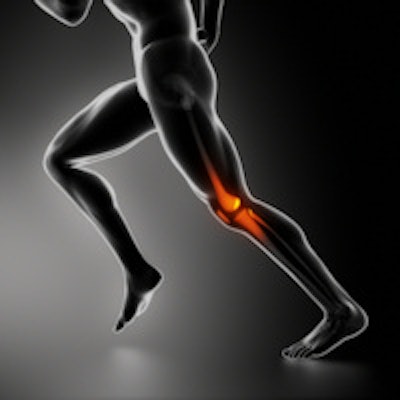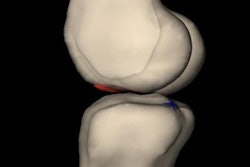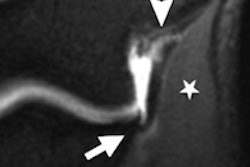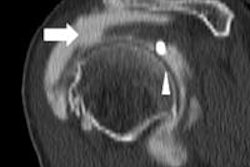
When an athlete is injured, the first instinct is likely to order an MRI, CT, x-ray, or ultrasound exam to determine the extent of the damage. However, such use of a potentially unnecessary and expensive scan can ignite debate among general practitioners, orthopedic and neurologic specialists, and radiologists.
To help discern the appropriate circumstances for sports-related imaging, the American Medical Society for Sports Medicine (AMSSM) recently released a list of recommendations as part of its participation in the Choosing Wisely campaign.
Like many other organizations around the globe, AMSSM wants to encourage conversations between patients and their physicians about the appropriate care for sports-related injuries.
AMSSM's list of recommendations includes avoiding the following:
- Brain CT or brain MRI to evaluate an acute concussion, unless there are progressive neurological symptoms, focal neurological findings on exam, or concern for a skull fracture
- Knee MRI for patients with anterior knee pain without mechanical symptoms or effusion, unless the patient shows no improvement after an appropriate functional rehabilitation program
- Knee arthroscopy as initial management for patients with degenerative meniscal tears and no mechanical symptoms
To image or not
When it comes to sports-related injuries, imaging does not have to be the first option, said Dr. Anand Lalaji, founder and chief medical officer of the Radiology Group in Atlanta.
 Dr. Anand Lalaji from the Radiology Group in Atlanta.
Dr. Anand Lalaji from the Radiology Group in Atlanta.
"There is a clear, clinical, legitimate reason for not imaging every person who may have a sports injury because there is still a lot to be gained from physical examination," Lalaji said. "There are specific physical exam tests that can be done on a patient's knee, ankle, elbow, or shoulder that will assess ligament patency, as well as tendon patency."
Dr. Thomas Magee, managing partner at NeuroSkeletal Imaging in Merritt Island, FL, said that as a radiologist he is not familiar with all of the symptoms that may warrant imaging, but a locking knee is a good indication that an MRI may be necessary.
"Then it is appropriate to order an MRI more quickly [rather] than later, the reason being that physical therapy in those scenarios won't work and may in fact be harmful," he said.
Referral issue
Most people with sports-related injuries go to their primary care doctor, who often refers the patient to an orthopedic specialist. "A large portion of orthopedic practices in the country have their own MRI machine," said Lalaji, who created the website InsideInjuries.com to educate people about sports injuries.
This has led to concern about imaging overutilization and physicians benefiting financially by using their own facilities. A 2013 paper from Duke University noted a lack of reliable data on the financial arrangements of imaging equipment ownership and details of the imaging diagnoses. In their study, the Duke researchers found that knee MRI exams are more likely to be negative if they are ordered by physicians with a financial interest in the imaging equipment being used.
"The inherent conflict of interest present when physicians both order and then perform and collect fees on the basis of the acquisition of MR imaging examinations is an important factor to consider whenever the matter of healthcare cost is raised," wrote lead author Dr. Matthew Lungren and colleagues in Radiology.Lalaji predicts more research will be conducted on image utilization in the near future to determine the volume of scans referred by internal or noninternal clinical practices.
The downside, he added, is that the U.S. Centers for Medicare and Medicaid Services (CMS) may look at these studies and start to cut reimbursement based on what the agency perceives as overutilization.
"Who that really hurts is the radiologist, because they are being penalized for it," he said.
Lalaji advocates more balanced utilization by requiring that a certain percentage of MRI referrals come from outside the practice. "That way there is a legitimatization of the examination and it will maybe cut down on the utilization," he said.
Appropriateness criteria
In the Protecting Access to Medicare Act of 2014, signed into law in April, there is a provision that requires physicians to consult appropriateness criteria when ordering advanced imaging procedures for Medicare patients. Physicians who have trouble complying with the requirement will be subject to a preauthorization process.
 Dr. Thomas Magee from NeuroSkeletal Imaging
Dr. Thomas Magee from NeuroSkeletal Imaging
Initiatives such as Choosing Wisely, which encourage careful review before ordering an imaging exam, are part of a "massive shift toward preauthorization to monitor image utilization," Magee said. "All these organizations are coming together to determine when is it appropriate to image. I think that is a good thing overall for the patient."
Magee works with some insurance companies on preauthorization and appropriateness criteria for imaging exams. In many cases, third-party payors generally prefer that a patient undergoes a six-week rehabilitation period to treat symptoms of an injury.
"After that, if they do not resolve, then consideration may be made to have an MRI performed for the knee-pain scenario," he said.
Malpractice threat
Another factor in overutilization is the threat of malpractice for physicians who do not order an imaging exam and then misdiagnose a patient's injury.
"Every type of specialty gets hit by this highly litigious type of behavior," Lalaji said. "When the patient is complaining of a cough or shortness of breath, they are more apt to get a CT scan of the chest, even if the patient has a history as a five-pack-a-day smoker. [Physicians] don't want to have a nondiagnosed lung cancer on their hands because they know it will invariably result in a lawsuit."
And when it comes to sports-related injuries in professional athletes, forget traditional imaging protocol.
"Everything I just described does not apply to the professional athlete," Lalaji said. "The professional athlete is in a completely different world, a different planet. The decrease in performance based upon what we, as laypeople, would consider a minor injury is massive to a professional athlete in terms of revenue and dollars."
Magee images professional athletes at his facility in Florida. Imaging is often done before an athlete signs a contract to assess his or her health and protect the team.
"If there is an injury -- for example, a hamstring injury for someone like myself -- there is probably no need to image that," Magee said. "Economically, if you give someone a multimillion dollar contract, how long will they be out? You can determine a prognosis with an MRI. So [an MRI] is important for the professional athlete, but for the weekend athlete, it's really not that important."



.fFmgij6Hin.png?auto=compress%2Cformat&fit=crop&h=100&q=70&w=100)




.fFmgij6Hin.png?auto=compress%2Cformat&fit=crop&h=167&q=70&w=250)











